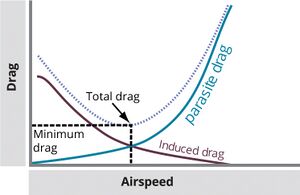Glide Extension
Jump to navigation
Jump to search
Glide Extension

Glide extension refers to techniques pilots use to increase the distance an aircraft can glide after engine failure. These techniques are critical for maximizing reach to a safe landing location.
Best Glide Speed (L/D Max)[edit | edit source]
This is the airspeed at which the aircraft can cover the greatest distance for each unit of altitude lost.
- Pilots should be familiar with their aircraft’s best glide speed, typically listed in the Pilot Operating Handbook (POH).
- Maintaining this speed ensures the aircraft glides efficiently and maximizes distance.
Wind Conditions[edit | edit source]
- Tailwinds increase ground speed, allowing the aircraft to cover more distance in the same time.
- Headwinds reduce ground speed, decreasing effective glide range.
- Pilots must account for wind direction and speed when planning a glide.
Other Factors[edit | edit source]
- Altitude: Higher altitude at engine failure increases potential glide distance.
- Aircraft Design: Different aircraft have different glide ratios.
- Flaps: Increase drag and reduce glide performance; should be retracted.
- Propellers: Coarse pitch (low RPM) reduces drag in aircraft with constant-speed propellers.
Glide Ratio[edit | edit source]
The glide ratio is the distance an aircraft travels horizontally for every unit of altitude lost.
- Higher glide ratios result in greater glide distance.
- A common estimate: 1.5 nautical miles per 1000 feet of altitude.
Glide Distance Calculation[edit | edit source]
To estimate glide distance:
- Glide Distance (NM) = Glide Ratio * Altitude (ft) / 1000
- Example: A glide ratio of 1.5 at 5000 feet gives a distance of 7.5 NM.
Configuration Tips for Glide Extension[edit | edit source]
Based on Flight Safety Australia:
- Maintain proper configuration: gear up, flaps retracted, cowl flaps closed.
- Reduce propeller RPM to decrease drag (if equipped).
- Avoid skidding/slipping turns, maintain coordinated flight.
- Fine-tune speed based on aircraft weight and conditions.
Practical Advice[edit | edit source]
- Visualize your glide range like a ring around the aircraft.
- Practice transitions from best glide speed to landing configuration.
- In some aircraft, leaving the gear up until landing surface is assured is advised.
- Practice "Power-off 180" maneuvers and short-field landings for proficiency.
References[edit | edit source]